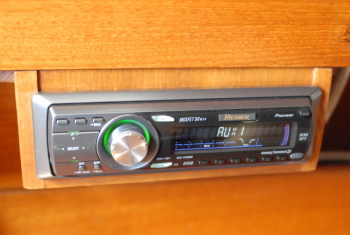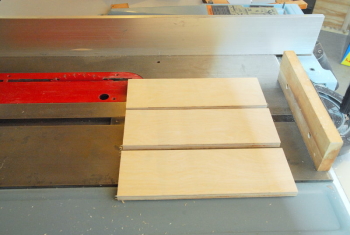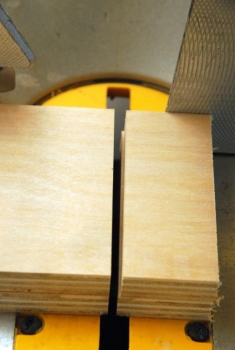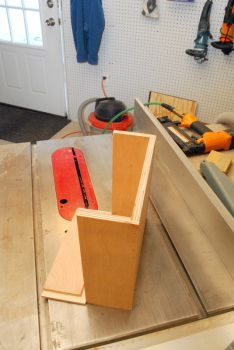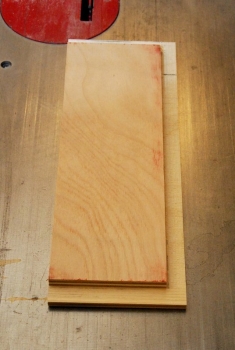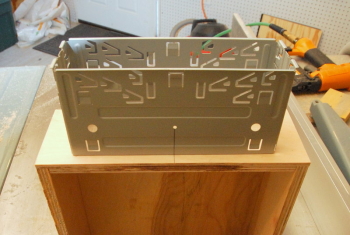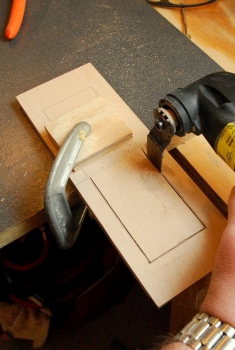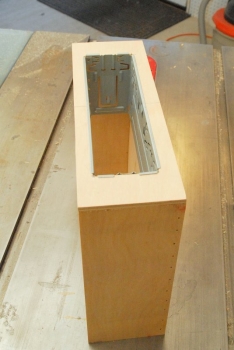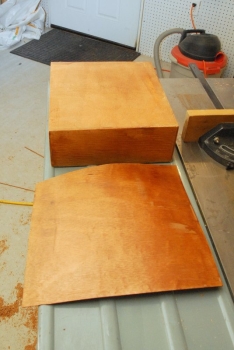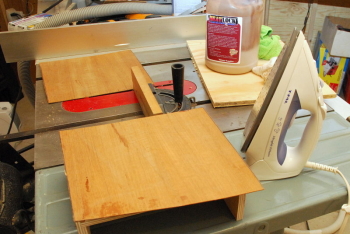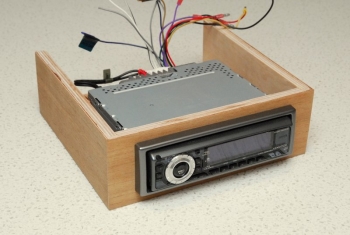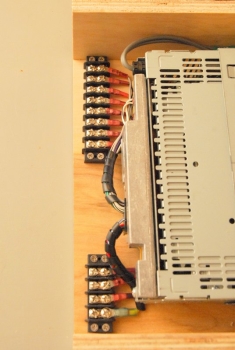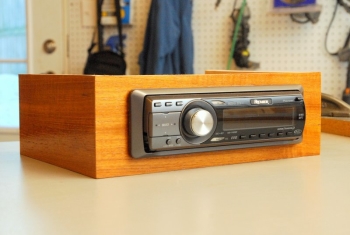The Old Stereo Enclosure
I had been meaning to address the issue of our boats stereo for a while and figured while doing the full Monty re-wire was as good a time as any.
The old stereo box bugged me because the PO (previous owner) had stained mahogany to match the teak. Most boat owners could live with this and never even notice, but the mismatch had me noticing it.
The major issue was the PO did not allow any room for air circulation in the old stereo enclosure. The stereo sat directly on the wood and scraped the edges as it slid in. It was so tight there was not even room for the face plate adapter which the stereo slides into.
To make a long story shorter the stereo would heat up, distort and eventually shut down due to over heating. Something needed to be done.
Begin The Cutting
After measurements were taken I chose the physical height I needed the enclosure to be, for air circulation, and then I ripped some 1/2″ marine grade Baltic birch plywood.
Because teak faced marine ply is soooo expensive, about $225.00-$275.00 per sheet, for 1/2″, I decided on a veneer.
My friend Tim was kind enough to drop off some extra-density veneer scraps he had kicking around.
Cut The Sides To Length
For the ripping part I cut them a little long then stacked the side and cut them together. I did this to be sure both sides were the exact same length. I could have used my saw stop, for repeatability, but it took less time to just stack them.
Clean Cuts For Veneer
When using any veneer you’ll want to use sharp blades in order to make clean cuts. I used a 40 tooth thin kerf Freud blade in my table saw, for expensive plywood though I sometimes rip with an 80 tooth. I used an 80 tooth Freud blade in my chop saw for cross cutting.
Dado The Sides, Glue & Brad Nail
The next step was to dado the edges where the sides and bottom met. I also used the dado blade to cut the front face so it to sat into the front not just on top of it. Once these cuts were made I glued and brad nailed the sides on.
For a small marine project like this I use 18GA stainless steel brad nails. These days stainless brad nails are available from places like Amazon but years ago you had to find a special woodworking supplier to get stainless brads. I use Bostich brand stainless brads. If you fill the nail head holes with wood flour or glue & sawdust you should be fine with even steel brad nails, especially under a veneer. I like the stainless brads because they never rust & bleed through in the moist marine environment.
The Face Plate
This is the face that the stereo will eventually sit into. I did not nail & glue it into the box until I had cut the opening for the stereo and confirmed the fit. I’d rather mess up before it has been glued and nailed to the enclosure because this would make starting over, due to a blunder, that much easier.
Mark The Centers
I marked the center of the face plate and then marked the center of the stereo case insert so I could align them for tracing. Once the outline was traced it was time to make the cut.
Cut The Face Plate Opening
To cut the opening in the face I was forced to use my Dremel Multi-Tool. Unfortunately my Fein Multi-Master was on a customers boat. Having back up tools is never a bad thing unless of course you get stuck with a POS tool like the Dremel multi-tool.. (grin)
In some instances, like this one, I really prefer an oscillating tool for precision work vs. a jig saw. For this task my Bosch jig saws base plate would not have even fit on the face plate without making it unstable. I often find I can do more accurate straight line cuts with an oscillating tool than I can with a jig saw. I use my Fein quite a lot and once you get used to it is a very versatile tool.
Test Fit The Face Plate & Stereo Adapter
Next I test fit the stereo’s metal mount into the box. From the original cut it did take a little bit of fine sanding with the oscillating tool before it slid in. With these DIN mounts there’s not much room for error. The front flange or lip is quite slim meaning any errors in cutting can result a do-over. These DIN boxes really need to fit almost perfectly.
Make Sure Everything Fits Perfectly Flush
Once the stereo case fit perfectly into the box I glued and brad nailed it to the rest of the enclosure. I then went to town with a long board and sand paper making all the surfaces perfectly flat for the veneer. The edge on the right is still a little proud in this photo, but I took it down flush with the rest of the box.
Apply The Veneer Glue
Tim dropped off a newer product I had not used before called Heat Lock. Heat Lock is a water based veneer glue that gets activated by the application of heat.. I rolled two coats onto both the veneer and the enclosure letting it dry about 20 minutes in-between coats.
After The Fist Coat of Veneer Glue
Here’s some veneer, and the enclosure, after the first coat of the Heat Lock glue.
Glue The Veneer To The Plywood
Once the second coat is dry you position the veneer, and orient the grain to your liking. You then use an iron, on high steam, to seal the veneer to the plywood. It really could not be any easier. After one use of Heat Lock I am a solid convert. I will likely never use contact cement, or wood glue, for veneer work again. I used to really dislike veneer work but Heat Lock makes it very easy.
Once the veneer and wood cooled I used my router and a bearing guided flush cut laminate bit to trim the edges. You’ll want to orient the veneers edges best for your situation. I had the sides over hang the bottom as no-one will be looking at the bottom and they will be seeing the sides.
Before Finishing
This is the finished stereo enclosure. I still need to do a final sanding, acetone wipe then varnish it to match the interior of the boat. The veneer Tim gave me is beautiful, quarter sawn, and quite thick. It was sourced from Boulter Plywood in Somerville, MA.
Wiring
For my wiring I wanted it neat and clean. I used adhesive lined heat shrink crimp connectors and nickel plated brass terminal strips from Blue Sea Systems. The speakers are all on the longer t-strip and the power & ground on the other to make it simple & neat.
The Finished Product
While not technically finished, because I will put a few more coats of varnish on, I wanted to complete the wiring and fitting first then I will sand and add a couple more coats. I’ve learned over the years that a coat or two in the shop is not a bad thing as it prevents handling stains from greasy fingers or some errant grease on a work bench that can mess up a beautiful piece of teak.
Over all the whole project took me about two hours to complete but it certainly looks a lot better than a plastic stereo housing like those sold at West Marine. This is an easy way to learn veneer work and an inexpensive enough project that you don’t go broke on teak veneer if you mess up.
A 2′ X 4′ sheet of quarter sawn teak veneer from Boulter Plywood runs about $33.00.
Good luck & happy boating!

